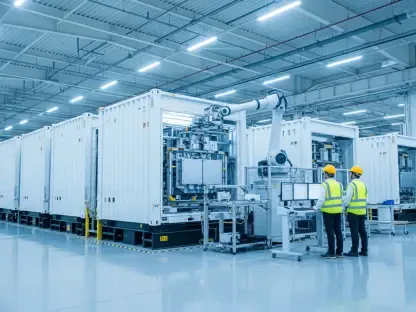In today’s rapidly evolving landscape of renewable energy, innovative solutions like gravity batteries are garnering attention for their potential to transform energy storage. Christopher Hailstone, an expert in energy management and renewable energy, shares his insights on the promise and challenges of gravity batteries, offering a glimpse into how this technology can reshape our approach to sustainable energy.
Can you explain how gravity batteries work and what makes them different from other energy storage systems?
Gravity batteries utilize the basic principle of gravitational force. They work by lifting heavy weights to store energy, which is then released in a controlled manner to generate electricity when needed. Unlike other storage systems that might rely on chemical processes or fluids, gravity batteries leverage potential energy from elevated weights, offering a straightforward and durable solution.
What role does gravity play in the energy generation process of gravity batteries?
In gravity batteries, gravity is the central force that enables energy generation. The system involves raising weights to store energy, and when energy demand peaks, these weights are allowed to descend under gravity, driving generators to produce electricity. It’s a brilliant use of natural forces to harness and dispatch energy as needed.
How do gravity batteries utilize renewable energy sources like wind and solar?
Gravity batteries are charged by renewable energy sources such as wind and solar. During times of excess production, this energy powers the mechanisms to lift the weights. This stored potential energy can then be converted back to electricity during periods of low renewable energy output, smoothing out the inconsistencies inherent in sources like wind and solar.
Why are abandoned mines considered ideal locations for gravity battery systems?
Abandoned mines provide a ready-made solution with their deep shafts and structural integrity. These features are perfect for implementing gravity battery systems because they require vertical drop spaces for the weights to descend. Utilizing these existing infrastructures helps reduce the initial setup costs and avoids additional environmental disruption.
How does the reuse of abandoned mines impact the environment compared to building new facilities?
By repurposing abandoned mines, we minimize environmental impact significantly compared to constructing new facilities. This approach mitigates the need for new land use, reduces construction debris, and avoids the ecological disturbances that come with building from scratch, making it a more sustainable and eco-friendly option.
What are the economic benefits of converting mining sites into gravity battery storage facilities?
Transforming mining sites into gravity battery facilities offers substantial economic advantages. It creates job opportunities and fosters local economic growth, revitalizing communities that once depended on mining. Moreover, it utilizes existing infrastructure, reducing the costs typically associated with starting from the ground up.
How do gravity batteries address the issue of the sporadic nature of renewable energy sources?
Gravity batteries offer a buffering solution to the intermittent output of renewable energy sources. By storing energy when production exceeds demand and releasing it when there’s a deficit, gravity batteries help maintain a steady energy supply, thus enhancing the reliability of renewable resources.
What advantages do gravity batteries have over traditional chemical batteries?
One of the key benefits of gravity batteries is their longevity and environmental safety. They don’t rely on hazardous chemicals that can degrade over time, nor do they pose disposal issues. Their simplicity, long lifespan, and reduced environmental footprint make them a more sustainable option.
Can you discuss the environmental benefits of using gravity batteries instead of relying on hazardous materials?
Gravity batteries eliminate the dependency on toxic materials used in conventional chemical batteries. This drastically reduces the environmental risks associated with mining, processing, and disposing of hazardous substances, aligning with the broader goal of sustainability.
What are the main challenges that gravity batteries face in reaching their full potential?
Currently, the biggest obstacles are the costs associated with initial setup and technology refinement. While the technology is promising, achieving cost-effective scalability requires further research and development to reduce financial barriers and enhance system efficiency.
Are there any current efforts to reduce the initial cost requirements of gravity batteries?
There is ongoing research aimed at decreasing the initial costs. Efforts include exploring cost-reduction strategies through innovative design, utilizing more affordable materials, and optimizing energy conversion processes to make gravity batteries a more accessible option for wider application.
What areas of research are being focused on to improve gravity battery technology?
Research is honing in on developing better materials for weights, more efficient winch and generator designs, as well as advanced control systems to boost overall system performance. These advancements are crucial for making gravity batteries more competitive and efficient.
How important is collaboration between academic institutions, businesses, and governments in the development of gravity battery technology?
Such collaboration is vital. Academic institutions drive innovation and research, businesses provide practical applications and scaling expertise, while government support can offer the necessary funding and regulatory backing. Together, these sectors can accelerate the development and deployment of gravity battery technology.
In what ways can gravity continue to play a major role in future energy systems?
Gravity will remain a fundamental force that can be tapped into for various innovative energy solutions. As we seek to enhance our energy storage capabilities, leveraging gravity could lead to novel applications and more resilient energy systems in the future.
What breakthrough discoveries do researchers hope to achieve through ongoing studies of gravity batteries?
Researchers aim to unlock more efficient methods of energy storage and conversion, possibly discovering new materials or configurations that could revolutionize the performance and cost-effectiveness of gravity batteries, thereby broadening their applicability in global energy systems.









